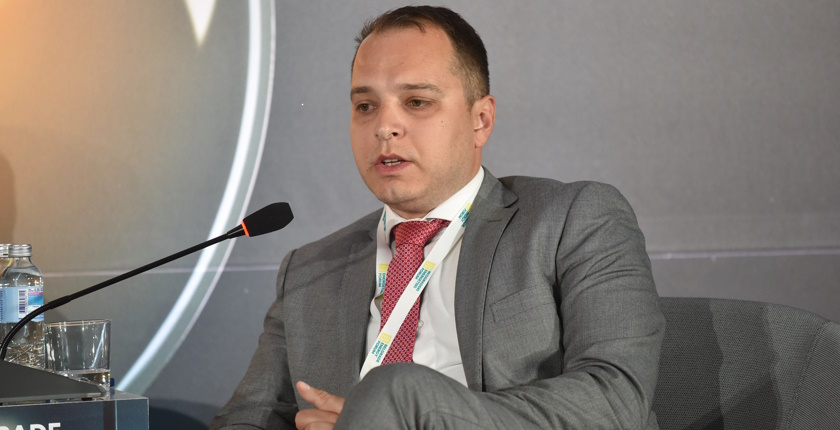
Matija Medojević
While Montenegrin Power Exchange (MEPX or BELEN) is waiting for a decision on which organized electricity market is to be coupled with, it is working on fulfilling the conditions for obtaining the NEMO status as well as for the market coupling, Chief Executive Officer, Matija Medojević, said in an interview with Balkan Green Energy News.
In partnership with the EPEX Spot and BSP SouthPool, MEPX launched the day-ahead market (DAM) in Montenegro in April. Would you say it took a while but was worth it?
Establishing an organized electricity market in Montenegro was never done before, so it was started from scratch, with help from the Energy Community Secretariat. It is a long-term and complex job, and many things did not go our way. For example, the coronavirus and the decision of a potential strategic partner, Nord Pool, to withdraw from the negotiations in 2020, which is why everything took more time, especially in the light of political instability in Montenegro.
But we still succeeded. Of course, we did it with the support of MEPX’s founders: power utility Elektroprivreda Crne Gore (EPCG), transmission system operator Crnogorski Elektroprenosni Sistem (CGES) and the Montenegrin Electricity Market Operator (COTEE), as well as the relevant ministries. The power exchange is, after all, seen as something good for Montenegro and one of the obligations from chapter 15 of the negotiations to join the European Union.
In the first tender for launching DAM, MEPX was looking for strategic partners, and in the second one just service providers. Why?
The second tender, for service providers, finished in October 2021, when the process of implementing DAM started. The idea of selecting a strategic partner to receive a share in MEPX was abandoned.
We were lucky that EPEX Spot applied. Along with Nord Pool, it is the most renowned company in the business. EPEX Spot’s offer included BSP Southpool as the clearing and settlement operator, and it proved to be a good combination, in line with all EU standards and practices.
That is the technical part of the DAM implementation, and the legal part also has its history. The power exchange became a part of the regulatory framework in 2019, but the Law on Value Added Tax also had to be changed. That was only completed in January of this year. The final part was the trading rules, and MEPX adopted them.
Why was the idea of a strategic partnership abandoned?
It was a more complicated model, generally. For example, it implied adopting a shareholder agreement and appointing people to management positions to represent the strategic partner, which was quite complex at the time, even though we were more than willing to do it.
It is not a bad idea, but the timing wasn’t right. The company we were negotiating with changed its ownership structure and withdrew completely from the Western Balkans at that moment…
In such a situation, it was easier to look for someone to provide the service rather than to become the company’s co-owner.
The average daily volume traded on MEPX is around 1,005 MWh, and the total volume since the start has topped 147 GWh. Are you satisfied with the results?

Everything is working perfectly, just like the cooperation between our team of engineers and the experts from France and Slovenia. Everything is going as we planned. The participants acknowledge that and see that everything works as in any European country.
We were lucky that we adopted the 10:15 a.m. gate closure time, so it is one of the first price signals in Europe for traders and surely the first in the Balkans. I think that in Europe only Ireland has an earlier closing time. Gate closure is at 10:35 in North Macedonia. In Serbia, it is at 11:00, and in Hungary at noon.
It is attractive for power exchange participants, which is evident from their number. At the moment, they are 22, more than what we planned. The companies have a substantial presence in the region. They are state-owned power utilities from Croatia, Slovenia, Serbia, and Italy, but also companies such as Alpiq, Petrol, GEN-I, and Danske Commodities.
Where do you see room for improvement?
In strengthening liquidity. It requires a strategic commitment by domestic firms to participate even more in MEPX. However, it would only have a short-term effect, while market coupling boosts liquidity permanently.
What are MEPX’s plans for the future? What is the status with regard to market coupling?
Clearly, the power exchanges in the region, even those established before us, are not an end in itself. It is just a step toward integration into the European market. This is why the obligation was introduced in the first place, as the first step toward the ultimate idea that there is a single European market where the same rules will apply to everyone, like an energy Schengen.
We have the obligation to acquire the status of the nominated electricity market operator (NEMO) by the end of the year, which is also a prerequisite for market coupling. We are now working on fulfilling these requirements.
The direction of market coupling is not defined, and it is not a matter for MEPX. The decision is up to state institutions at a higher level.
This is a very important and urgent issue. Possible directions are more or less known, but our founders and the Government of Montenegro have the capacity to make the decision. We are trying to do what is up to us and to be ready when the decision is reached.
Which are the possible partners?
Italy and Serbia.
In addition to Montenegro, the Western Balkans region witnessed the launch of two more power exchanges – in Albania and North Macedonia. What does this mean for the region, the energy transition and the countries themselves?
It is important for the region because everyone intends to join the EU, and it is a condition. Additionally, power exchanges enable easier integration of renewable energy into the grid, accelerating the energy transition and making it less painful.
It also allows smaller producers of green energy to market their goods more easily, encouraging new investments.
Finally, thanks to the power exchange, EPCG can sell and buy at more favorable prices. It contributes to its results and enables it to offer prices more favorable for households.









An interesting development. But the core of the problems in the region with regard to an efficient common market with a suffucient liquidity is perfectly described in the phrase: “It is important for the region because everyone intends to join the EU, and it is a condition”. It means that the drivers for the markets are external, not inherent to the economics of the countries.